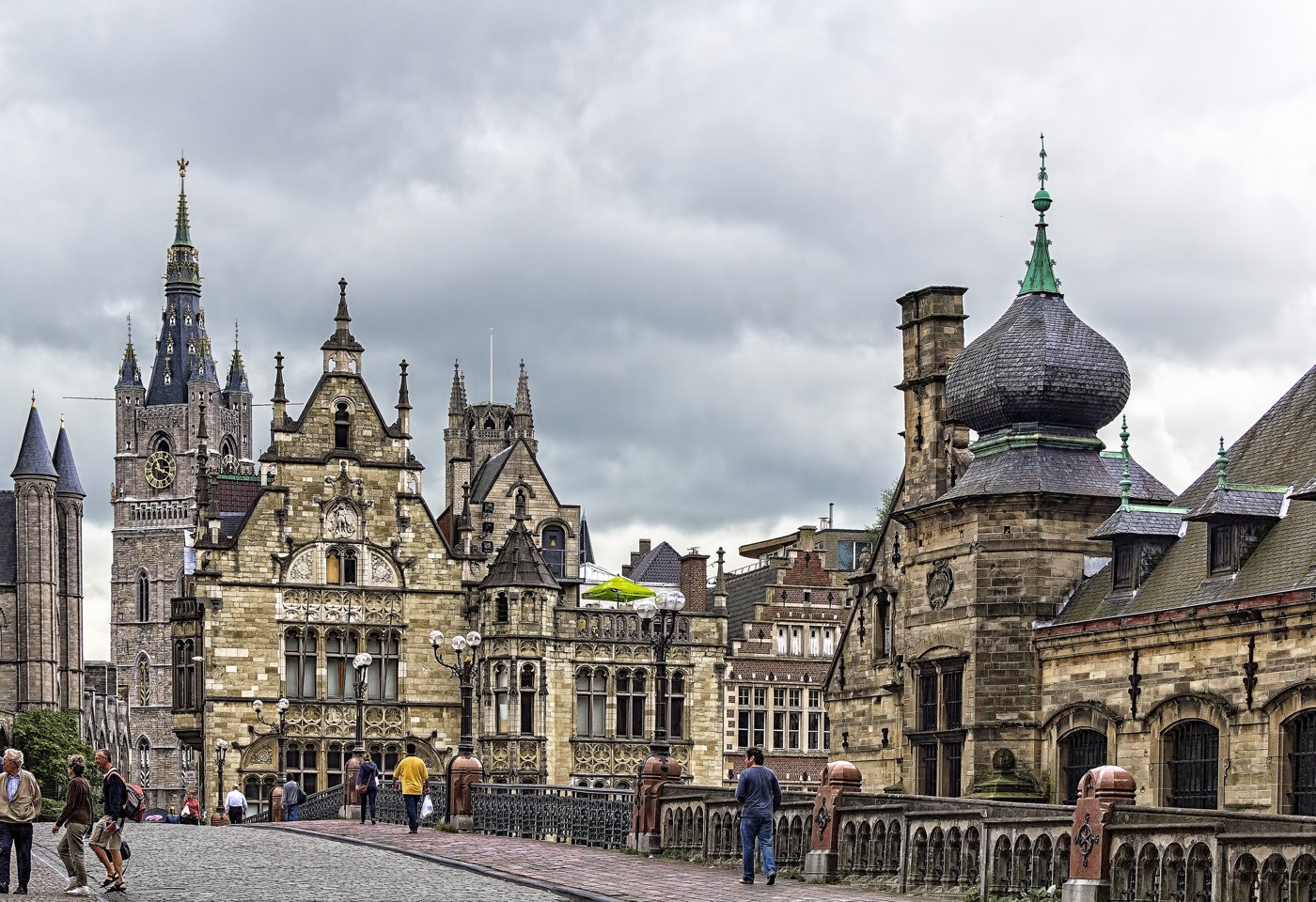If you’ve been to Flanders—Belgium’s northern reaches—chances are you’ve explored Brussels, from its gourmet restaurants and chocolate shops to its Manneken Pis, or Petit Julien, one of the world’s most beloved statues. Possibly, you’ve toured Bruges, where mists rise moodily over canals plied by flat bottomed barges and lined with medieval stone houses. You might even have ventured to Antwerp, capital of the world diamond trade, a major European art venue, and site of a charming in-city zoo right next to an ornate central train station.
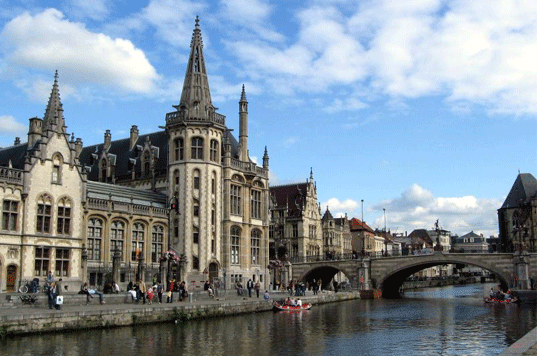
But Ghent?
East Flanders’ capital and largest city lies about midway between Brussels, Bruges and Antwerp, but foreign visitors often bypass the city. Ghent is Belgium’s fourth-largest city, and has a vibrant restaurant scene, scores of chocolatiers, and even its own Manneken Pis. Like Bruges, it has canals, and its two in-city rivers, the Lieve and the Leie, have been “canalized,” dug out and straightened to give the appearance of canals. Like Antwerp, Ghent also has a lively art scene. In fact, the city is home to the 15th-century “Adoration of the Mystic Lamb,” a.k.a the Ghent Altarpiece, a 12 panel religious work by Jan and Hubert van Eyck. Having a major van Eyck in its portfolio would be enough to cement Ghent’s reputation as a European art center. But this is no ordinary masterpiece. Critics consider it the first major work of the Renaissance, the seminal work from which all other great Renaissance paintings flowed. Indeed, if the altarpiece were moved to Paris, declared American art historian Noah Charney, “it would easily knock the Mona Lisa off its throne.”
Ghent—or Gent in Flemish, Gand in French—is certainly an amalgam of Flanders’ best. But what’s really best about Ghent is its individualistic, even quirky nature. “Ghenttitude” initially reveals itself in the tourist brochures. One states that everyone is welcome as long as they don’t behave like drunken tourists. Another says if you don’t like the way things are done in Ghent, go home. And yet another opines: “In Antwerp, you can win a debate with the loudest voice; in Ghent, we just ignore you.” That “in-your-face” style typifies Ghentian tourism promotion—take it or leave it.
Gentenaars, as the locals are called, have had centuries to perfect their independent streak. From 1,000 to 1,500 A.D., when Ghent was second in size only to Paris and controlled Europe’s lucrative textile trade as well as the major river routes to the North Sea, they refused to be conquered. When they finally were conquered in the 16th century, they refused to follow their new ruler’s edicts. So in 1540, Emperor Charles V forced them to parade through the streets wearing nooses around their necks. What was initially contrived as a mark of humiliation has, in true Ghentian fashion, been turned into a badge of pride. On major occasions like the 10-day Ghent Festival, which draws upwards of 1.5 million visitors each July, locals parade through the streets wearing miniature nooses around their necks.
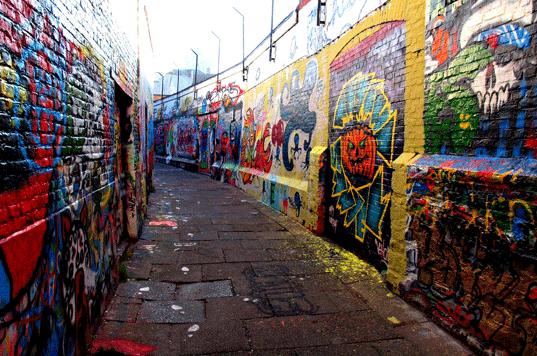
Irreverent ancestors certainly contributed to the locals’ independent, individualistic character, but so have today’s youthful residents. Like most Flemish cities Ghent is small, yet it has a student population of 65,000 who attend the University of Ghent and other academic institutions and conservatories. A populace fueled by youthful energy and innovation give Ghent the feel of a Cambridge, Massachusetts, or a Berkeley, California. It has also resulted in what rock-star Prince has called “the funkiest place in the world.”
How funky? Well, consider food, for starters. Ghent is the home of “the Flemish Foodies,” three of Europe’s most innovative young chefs, including Michelin-starred Kobe Desramaults of De Vitrine, Olly Ceulenaere of Volta and Jason Blankaert of the recently opened J.e.f. Despite the high flown culinary pedigree, Ghent also bills itself as the “Veggie Capital of Europe,” boasting the continent’s highest number of vegetarian restaurants. To prove it, there’s an official map listing scores of establishments. Not into vegetarian? Try Raj Bathhouse, where you can nibble on Indian treats after taking a sauna, or “a sewing café” called BoHo where you put several stitches in your latest garment, then relax with a simple meal and a few drinks. Even the most time honored Belgian culinary traditions have been “Ghentrified.” Take fries, or chips, as they’re called in this part of the world. Throughout the country, they’re eaten with mayo. But the Ghent topping of choice is stoverijsause mee mayonaise—a beer-infused brown meat sauce mixed with mayonnaise.
What about art and culture? Aside from the Ghent Altarpiece, which could cover an entire wall, there are some 30 graffiti walls in the center city, also listed on maps extolling the city’s two greatest graffiti artists, Bue the Warrior (who specializes in color pieces) and Roa (who works in black and white). There are quite a few well-respected museums, including S.M.A.K. (the Municipal Museum of Contemporary Art); MSK (the Museum of Fine Arts) featuring Flemish masters like Bosch, Rubens, Magritte and van Dyck; and STAM, the new city museum. Yet, housed in Belgium’s oldest psychiatric hospital is one of the city’s most beloved institutions, the Dr. Guislain Museum, whose offbeat collection includes an early brain cutting machine and disembodied testicles under glass.
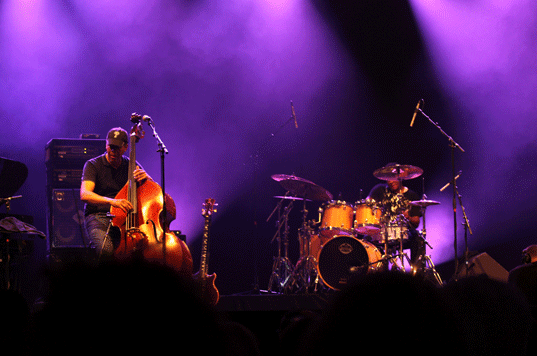
Travelers clever enough to put Ghent on their itineraries usually arrive by train, thirty minutes northwest from Brussels, forty-five southeast from Antwerp, and an easy trip from Amsterdam, London or Paris. Trains stop in Gent-Sint-Pieters Station, a gray-stone bulwark with enough turrets to make you wish you’d ridden into town on your destrier, or at least packed your lance and longbow. Upon arrival, pick up a bus and tram map at the station. From its east side, trams, buses (and taxis) take visitors on a 15-minute ride to the Old City, about a mile north. Or, rent a bicycle in Sint-Pieters Station from Max Mobiel, open daily, except Sunday; closed December and January. You have, after all, just arrived in what city promoters call “the most bike-friendly city in Europe.”
If you’ve come just for the day, start your explorations in the old city. But if you were wise enough to book several nights in Ghent, check into your hotel first. Like any city worth its salt, Ghent has a handful of multinational hotels, including a Marriott and a Novotel, as well as charming canal-side houses with stepped-gable roofs.
To really immerse yourself in Ghent’s trademark quirkiness, stay in one of the city’s bed-and-breakfast inns. Bed & Breakfast Gent puts out a map describing more than 75 B&Bs. Or contact the Ghent Tourist Information Office and ask for specific recommendations, not just about the establishments but also about your prospective hosts.
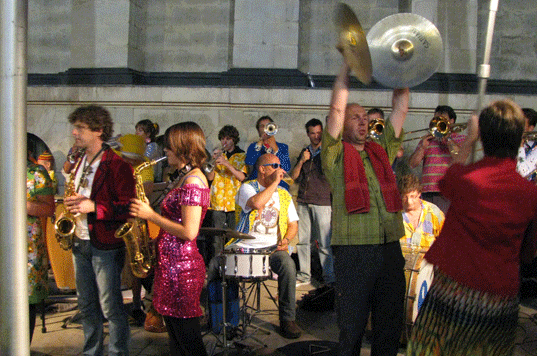
Into music? Ghent, a UNESCO City of Music like Glasgow and Seville, has an opera house, various classical venues, and a thriving club scene for jazz and virtually any kind of contemporary music. You might even be lucky enough to be in town for one of the city’s music festivals—Gent Jazz (one of Europe’s top 16 jazz festivals, held in July), the free Jazz in ‘T Park concerts (including midnight screenings of jazz documentaries in the Koning Albertpark), or the classical Festival Van Vlaanderen, to name just a few. Why not ask for a host who is into music, too?
Want to try the best—or most offbeat—restaurants? Some innkeepers can point you in the right direction. Skeptical that anyone from a city tourist office could provide such specifics? Well, think again. For all of Ghent’s cosmopolitanism, for all its world-class restaurants, bars, cultural institutions and dance clubs, the city is one of Europe’s biggest small villages. As a student lucky enough to attend the university here put it, “In Ghent everyone knows each other like one big family.” Not surprisingly, if you’re also lucky enough to be born—or to give birth—in Ghent, the streetlamps in Sint-Veerleplein, one of the old city’s main squares, will come on during the day so everyone can celebrate. Does it get more small town than that?
Once you’re settled, spend your first day strolling the Old City, at Ghent’s northern edge. Begin in Sint-Veerleplein, an L-shaped square at the y-shaped confluence of the Rivers Lieve and Leie. The Castle of the Counts, or the Gravensteen, a gray-stone authentically medieval pile topped by heraldic flags lowers over the narrow square threatening to burst its very seams. If there’s time, pop inside to visit the dungeons, and gawk at knightly arms and medieval instruments of torture. Built in 1180, the castle is authentically medieval, but several windows were added for the city’s 1913 World Exhibition.
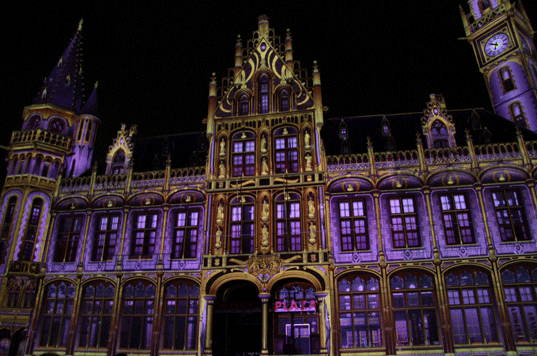
A few other Ghent landmarks were similarly tweaked. In fact, there are two Masons’ Guild Halls because overzealous reconstructionists somehow overlooked the original 16th-century hall near Sint-Niklaaskerk and decided to build another along the Kraanlei, Old Town’s lovely canal-side promenade. Don’t be surprised if a local jokingly brings up the matter of Ghent’s 20th-century “medievalization.” Gentenaars are blessed with more than their fair share of pride, but they also don’t mind a little humor at their own expense. That, along with their intellectual and creative bent, is what makes them so likable.
While in Sint-Veerleplein, stop at the new Tourist Information Office (No. 5), and surf city attractions on the state-of-the-art computerized light table designed by hip Belgian artist Arne Quinze. Be sure to pick up maps and brochures, especially the quirky USE-IT Europe “Map of Ghent: Made by Locals for Young Travelers.” You also can purchase a Museum Pass (20 Euros), good for three days’ admission to 14 museums and monuments as well as use of the local De Lijn public buses and trams. Next door is one of the city’s hottest new eateries, Bord’Eau, a contemporary style seafood restaurant with big picture windows right on the river and an outdoor terrace in summer.
Head south over the bridge to the 15th-century Groentenmarkt, or Great Butcher’s Hall, where cured Ghent hams, or Ganda hams, hang from big wooden rafters as in days of old. Enjoy simple Ghent fare here—like waterzooi, the national stew supposedly invented in Ghent—or coffee or tea with a couple of bagel-like buns called mastellen. While there buy Ghent gourmet specialties like the pyramid-shaped candies called cuberdons, various kinds of genever, or gin, and assorted mustards from Tierenteyn, whose shop is just across the square.
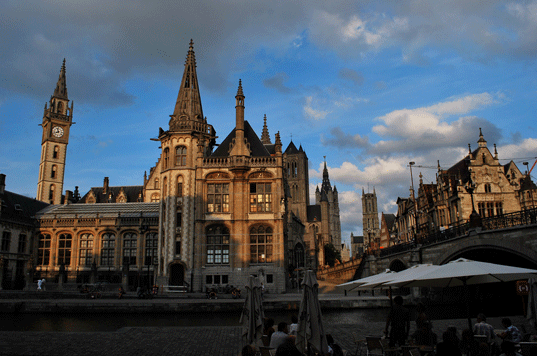
When you’re done, make a left at the Langemunt, a major thoroughfare, then hang a right into the Vrijdagmarkt. By now, you’ve probably noticed that old-city Ghent, like Bruges, is a warren of small pedestrian squares, or pleins, that flow gracefully into one another. Some squares are named for markets held here in centuries past and still held today; others for medieval professional guilds once headquartered there, and still others for various saints, like Baaf, or Bavo, whom most Catholics on this side of the Atlantic have never heard of. Nowadays, the Vrijdagmarkt—site of a Friday and Saturday market for clothing and other goods and a Sunday bird market—is also known for Friday night blowouts in bars like De Dulle Griet, where you hand over a shoe as a deposit for using one of Ghent’s trademark tall hourglass shaped beer mugs in wooden frames.
Just outside Vrijdagmarkt is Sint-Jacobskerk, or St. James Church. From there, take Belfortstraat to Sint-Baafsplein and Sint-Baafskathedraal, home of the aforementioned “Adoration of the Mystic Lamb,” or Ghent Altarpiece. Art lovers won’t want to miss this elaborate masterpiece. But be forewarned: The cathedral and a separate chapel housing the altarpiece are open daily, but on Sunday, the altarpiece chapel is only open 1-4 p.m. Check out several other buildings on Sint-Baafsplein and nearby Limburgstraat, like The Belfry, a UNESCO World Heritage Site topped by a gilded dragon. Take the elevator to the 215-foot-high gallery for panoramic city views, or on Sunday enjoy a centuries old tradition, carillon music, 11:30 a.m.-12:30 p.m. Just behind the square, is Bij Sint-Jacob’s, or Beverhoutplein, a pocket square shaded by plane trees. This is the centerpiece of the Ghent Festival in July. Throughout the year, a popular flea market is held on Friday, Saturday and Sunday, 8 a.m.- 1 p.m.
Heading north along the crescent shaped curve of Limburgstraat, you’ll soon reach another major church, Sint-Niklaaskerk, known for its baroque altarpieces and life sized statues of the Apostles. St. Nicholas is across from Restaurant C-Jean, where “Flemish Foodie” Jason Blankaert once reigned and which the city newspaper once hailed as the city’s best. Peek into St. Nicholas Church, then cross the Michielshelling Bridge. From the vantage point of Sint-Michielskerke—known for masterpieces like van Dyck’s “Christ on the Cross,” the three towers of St. Nicholas, St. Bavo and The Belfry line up perfectly for a perfect photo opportunity.
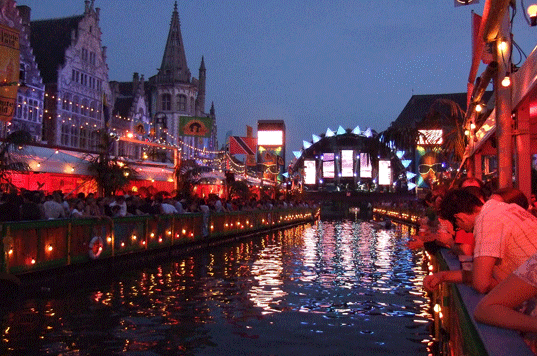
At this point, if you only allowed yourself one day in Ghent, you can be forgiven for hurriedly hopping a tram or bus back to Sint-Pieters Station for the ride back to Brussels or on to Antwerp. But you’ll probably never forgive yourself. If only you had only carved out three days in Ghent! Imagine the possibilities!
Tomorrow, you might have hopped aboard a flat-bottomed boat for a dreamy river or canal cruise. Or you could have headed to Citadelpark to browse S.M.A.K’s contemporary works or MSK’s old masters. That night you might have strolled just east of the Castle of the Counts to the Patershol, the medieval enclave that’s become a trendy restaurant district. Or you could have patronized one of the many international restaurants stretching from nearby Oudburg Street all the way to Sleepstraat.
The next day, your third in Ghent, you might have spent the day visiting the city’s old monasteries, perhaps St. Peters Abbey, now an art center with a garden and in-city vineyard. Or perhaps Old St. Elizabeth Beguinage, one of the city’s three original beguinages—medieval religious communities where women stayed, often for years, while their husbands were off fighting the Crusades. You could have wandered around the student quarter, Sint-Pietersplein, just northeast of the train station–browsing the hip shops and boutiques then sampled the many restaurants, bars and music clubs by night.
What if you had chosen to spend five days—or even a full week—in Ghent? Then you really could have discovered all the ins and outs, all the narrow passageways and hidden lanes, all the marvelous lesser known cafés and bars of this city many rightly call “Europe’s best-kept secret.”
The country code for Flanders is 32.
Where to Stay:
Guild of Gent Guesthouses (Bed & Breakfast Gent) – Information on more than 75 B&Bs, ranging from 1 to 11 rooms, with private or shared baths, gardens and/or swimming pools. www.bedandbreakfast-gent.be
Hotel Gravensteen – Overlooking the Castle of the Counts, this three-star hotel has 49 rooms in the former 1865 home of a Ghent textile baron. Jan Breydelstraat 35, Ghent. 32 (0) 9-225-11-50. www.hotelgravensteen.be
Hotel Harmony – Right on the Kraanlei, overlooking the canal, this four-star hotel, created from 18th and 19th-century houses, has indoor parking, a breakfast room, a lounge, bike rentals, and gracious rooms as well as studios with kitchenettes. Kraanlei 37, Ghent. 32 (0) 9-324-26-80. www.hotel-harmony.be
Marriott Ghent – On the far side of the River Lieve, near the Korenlei, the four-star Marriott has 139 well-appointed rooms, a restaurant and two lounges. Drabstraat, Ghent. 32 (0) 9-233-93-93. www.marriott.com
Novotel Gent Centrum – Centrally located near Town Hall, facing The Belfry, this 117-room hotel, part of the well-known European chain, has contemporary rooms as well as a bar and restaurant. Goudenleeuwplein 5, Ghent. 800-221-4542, 32 (0) 9-224-22-30 or 32 (0) 9- 293-9002. www.novotel.com
Where to Eat & Drink:
BoHo Café & Atelier – Stitch up a new frock, or a medieval-style tunic, complete with leather laces, then down snacks and a few beers here. Vrijdagmarkt 26, Ghent. www.boho.be
Bord’eau – Right on the river, with floor-to-ceiling picture windows and high metal-beamed ceilings, this is a stylish place to have a drink, or dine on fish and other Ghent specialties. Sint-Veerleplein 5, Ghent. 32 (0) 9 223 20 00. www.bordeau.be
Café Theatre Restaurant/Bar – In the Arts District, next to the Vlaamse Opera Ghent, this brasserie-style restaurant, with a cheery young staff, serves salads, stews and other light fare. Schouwburgstraat 5, Ghent. 32 (0) 9 265-05-50. www.cafetheatre.be
C-Jean – A “Flemish Foodie” restaurant offering innovative dishes made with fresh meats, fish and vegetables, plus an extensive wine list chosen by an award-winning sommelier, served in a contemporary black-and-white space in Old Town, just west of Sint-Baafsplein. Cataloniestraat 3, Ghent. 32 (0) 9-223-30-40. www.c-jean.be.
De Dulle Griet – Right in the old town, a venerable, if touristy, beer-drinking establishment. Vrijdagmarkt 50, Ghent. 32 (0)9 224 24 55. www.dullegriet.be
De Vitrine – This “Flemish Foodie” original in an old butcher’s shop in the city’s red light district serving upscale bistro food using fresh local ingredients. Brabantdam 134. 32 (0) 9 336-28-08. www.de-vitrine.be
J.e.f – A trendy new eatery, with white walls, black lamps and simple wooden tables and chairs, recently opened by “Flemish Foodie” Jason Blankaert. Lange Steenstraat 10, Ghent. 32 (0) 9-336-80-58. www.j-e-f.be
Julie’s House – In the old town, stop in the cozy upstairs salon or on the run to sample delectable cupcakes and other pastries “baked with love.” Kraanlei 13, Ghent. 32 (0) 9 233-33-90. www.julieshouse.be
Raj Bathhouse – Spend 22 Euros for a three-hour sauna session, and then snack on Indian treats. Corduwaniersstraat 4, Ghent. 32 (0) 9 223-37-32. www.saunaraj.be
Volta – Another “Flemish Foodie” establishment serving dishes made from local fish, meats and produce in a dramatic converted turbine hall with high ceilings and tiled floors. Nieuwe Wandeling 2b, Ghent. 32 (0) 9 32-40-500. www.volta-gent.be
What to See:
The Belfry – Sint-Baafsplein, Ghent. 32 (0) 9-233-39-54. www.gent.be/belfort
Castle of the Counts (Gravensteen) – Sint-Veerleplein, Ghent. 32 (0) 9-225-93-06.
Design museum Gent- Jan Breydelstraat 5, Ghent. 32 (0) 9- 267-99-99; www.designmuseumgent.be
Dr. Guislain Museum – Jozef Guislainstraat 43, Ghent. 32 (0) 9-216-35-95. www.museumdrguislain.be
Ghent Altarpiece (“Adoration of the Mystic Lamb”) – Sint-Baafskathedraal, Sint-Baafsplein, Ghent. 32 (0) 9-225-16-26.
Great Butcher’s Hall (Groetenmarkt) – Groetenmarkt 7, Ghent
MSK (Museum of Fine Arts) – Fernand Scribedreef 1, Citadelpark, Ghent. 32 (0) 9-240-07-00. www.mskgent.be
Old St. Elizabeth Beguinage – Beginjhofdries, Ghent. www.elisabethbegijnhof.be
SMAK (Municipal Museum of Contemporary Art) – Citadelpark, Ghent. 32 (0) 9-240-76-01. www.smak.be
STAM (Ghent City Museum) – Godshuizenlaan 2, Bijlokesite, Ghent. 32 (0) 9 267-14-00. www.stamgent.be
St. Peter’s Abbey (art center, garden, vineyard) – Sint-Pietersplein 9, Ghent. 32 (0) 9-243-97-30. www.gent.be/sintpietersabdij
Who to Contact:
City Trip Planner – www.citytripplanner.be
Ghent Guides –Bijlokekaai 2. 32 (0) 9-233-07-72. www.gidsenbond-gent.be
Ghent Tourist Information – Sint-Veerleplein 5, Ghent. 32 (0) 9-266-56-60. www.visitgent.be
Max Mobiel bike rentals – Sint-Pieters Station, Ghent. www.max-mobiel.be

